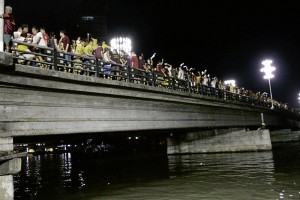Black Nazarene devotees warned on 2 old bridges

WEIGHT OF FAITH Devotees cram MacArthur Bridge in Manila during last year’s Black Nazarene procession. Authorities now say they better be careful not to overload the decades-old bridge when they join Wednesday’s feast. INQUIRER PHOTO
Amid the religious frenzy comes a word of caution.
Officials on Tuesday issued warnings about the state of two old bridges in Manila, saying their “live load” must be regulated as millions of Catholic devotees gather Wednesday for the annual Black Nazarene procession.
The Department of Public Works and Highways (DPWH) said Secretary Rogelio Singson had written Manila Mayor Alfredo Lim, informing City Hall that a recent technical inspection by the department’s Bureau of Design found MacArthur and Quezon bridges to have “corroded members which affect their structural integrity.”
“We need to ensure public safety, thus, there is a need to reduce the live load on either bridge during the traslacion (procession) activities,” a DPWH statement quoted Singson as saying.
People joining the procession should use “only one lane” of MacArthur Bridge, while the other lane may still be used for light vehicle traffic, the secretary added.
Article continues after this advertisementAlthough Quezon Bridge is not on the procession’s route, Singson said, there is a possibility that devotees would crowd this bridge to view the Black Nazarene as it passes under the bridge.
Article continues after this advertisement“We should exercise extreme caution on the use of the two bridges in order to avoid untoward incidents from happening,” he stressed.
In a radio interview, Singson said MacArthur Bridge, in particular, which crosses Pasig River and connects the P. Burgos Area to Carriedo, may not be able to support an unusually heavy load due to its old age and “progressive corrosion.”
“It is also very narrow. If people will be pushing each other during the procession, they could fall off the bridge,” Singson said.
Metropolitan Manila Development Authority Chairman Francis Tolentino said traffic constables will be posted to warn people against congregating in large numbers on the bridges.
Quezon Bridge was originally known as Puente Colgante when it was inaugurated in 1852. It was renamed and reinforced with steel in the 1930s.
Around 10,000 personnel from the police, civilian public safety agencies and volunteer groups are being deployed Wednesday along the procession route to boost security, impose order and respond to emergencies.
Last year, the Philippine National Red Cross reported that at least 33 people were injured during the procession while 40 fell ill, mostly due to high blood pressure.
Police estimated that up to 11 million devotees would show up for this year’s feast, more than the 8 million who crammed the streets from Quirino Grandstand to Quiapo Church in last year’s procession that took 22 hours to finish.